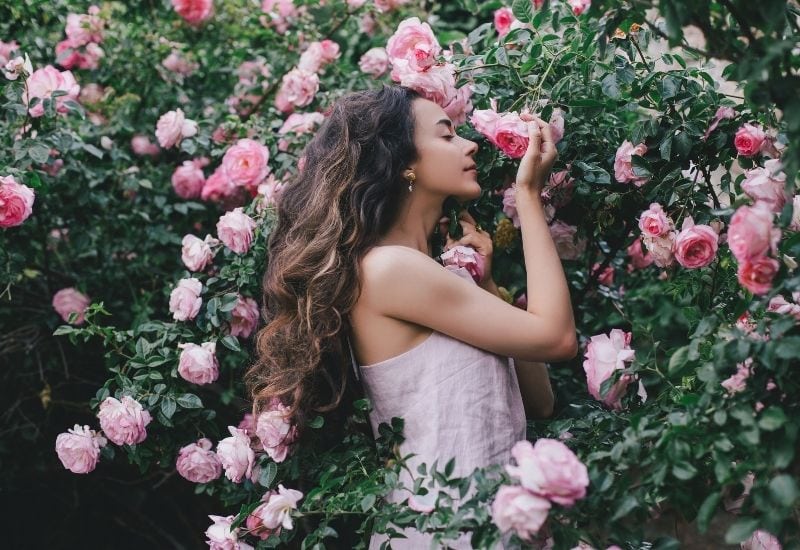
There are many beautiful flowers that have an amazing scent, but few can match the intoxicating fragrance of a rose. The fragrance of roses is the sweetest of all flowers, experts say. And when you grow them in your garden they add an “aroma-scented” atmosphere with their wonderfully scented blooms.
Natural roses and some cultivars have strong, even intoxicating scents, but it’s not juts the quantity you want… Each rose has its own distinctive aroma; if you thought they were all the same, I am going to convince you they are not, with the most fragrant roses of them all!
Roses can have strong, medium, weak or no fragrance. But they also have different types of fragrance, grouped into myrrh, fruity, musk, old rose and tea rose. You can choose among the best smelling varieties by the quality of the perfume, but you will also need to consider size, hardiness, color and shape.
For this reason I am going to give your garden, your nose and that of your guests a little present now: the selection of the most intoxicating roses you can have! And you can match the rose with what your garden offers with light, space and temperature, so you can make sure it smells great!
So, if you love this flowers and if you want your garden to have a sweet olfactory dimension, we’ve compile a list of the most fragrant rose varieties to delight your senses.
Use these samples as inspiration for creating scented summer garden or just enjoy them in pots on your porch.
Types of Rose Smells
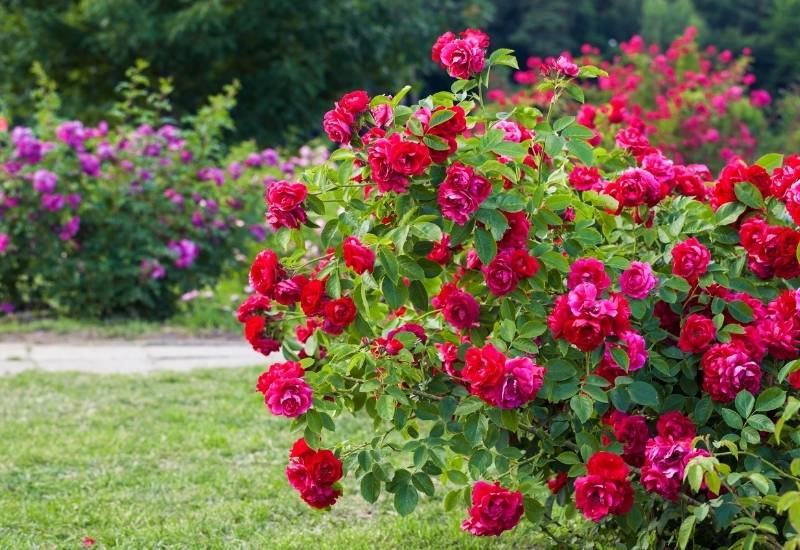
But is “nice” or “sweet” all we have to describe the complex notes and nuances of the perfume of roses? No, it’s not, and we are going to learn how to describe them correctly right… now!
We all have problems describing smells, even that of roses. We end up using vague words like “nice” and “bad” or “whiffy”… Let me introduce you to the technicalities of rose fragrance.
Roses have 5 key smells, which are often mixed in different percentages within each rose. Here they are:
Great, now you know how to analyze rose fragrance, let’s have a round of fun facts about these love enhancing flowers…
Roses and Fragrance: Fun Facts
I know you have a few questions about roses and fragrance, and I want to give you the answers straight away. Here they are.
When do roses smell best?
Roses smell best with their first blooms usually in spring, and they also have specific temperatures, actually at exactly 77oF (25oC). High humidity intensifies the scent too. Don’t be worried then if your roses have different degrees of fragrance throughout the year or even during the day! In fact, they will have a stronger perfume in the morning..
Are there roses that do not smell?
That’s a big question! To us Humans yes! Natural roses always have some scent, even if light. But some hybrids and cultivars totally lost their aroma. That is, for our nose. We would need to ask a dog or a bee to know the full truth.
Is the scent of a rose always the same?
Not at all! When the rose is still a bud, it has a different perfume quality than when it’s open. And even the same rose can vary its actual combination of notes during its life! This is something for experts.
How common is rose fragrance in perfumes?
Rose oils are very common in modern perfumes, allegedly they are present in 10% of all male perfumes and a whopping 75% of female ones!
Are roses used in aromatherapy?
Absolutely, rose oils are used to abate depression, to relax and to increase sex drive. On the whole, roses are related to self love, so, they are good for all problems with confidence and anxiety.
How long have roses been used in perfumes?
We don’t actually know, but for sure we are talking millennia! The Egyptians already used this fragrant flower to make intoxicating potions, even back then, they were used to enhance love…
And if love of roses and their scent is what has brought you to this article, here is the moment you have been waiting for: open your eyes and your nose, because you are going to meet the most fragrant roses in the world!
The 18 Most Fragrant Roses in the World That Smell Heavenly
Here are the 18 of the most fragrant rose varieties to will fill Your garden with heavenly aroma all year long:
1: Rose ‘Desdemona’ (Rosa ‘Desdemona’)
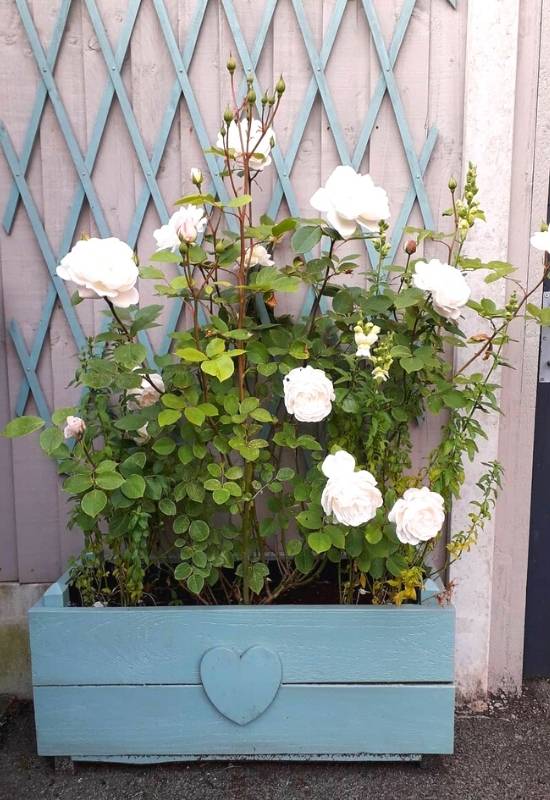
The classically inspired and traditionally looking ‘Desdemona’ is a small shrub rose with strong old rose scent and candid white flowers with a light pink hue in them.
The buds are pink in color, but they turn white when they open. The blooms are cupped and large, about 4 to 5 inches across (10 to 12 cm). They are fully double, with 26 to 60 petals for each head.
This is a small plant, which makes it ideal for containers and pots. You can have a strong smelling rose, with a rare scent for a white one, even if you just have a small space…
2: Rose ‘Francis E. Leicester’ (Rosa ‘Francis E. Leicester’)
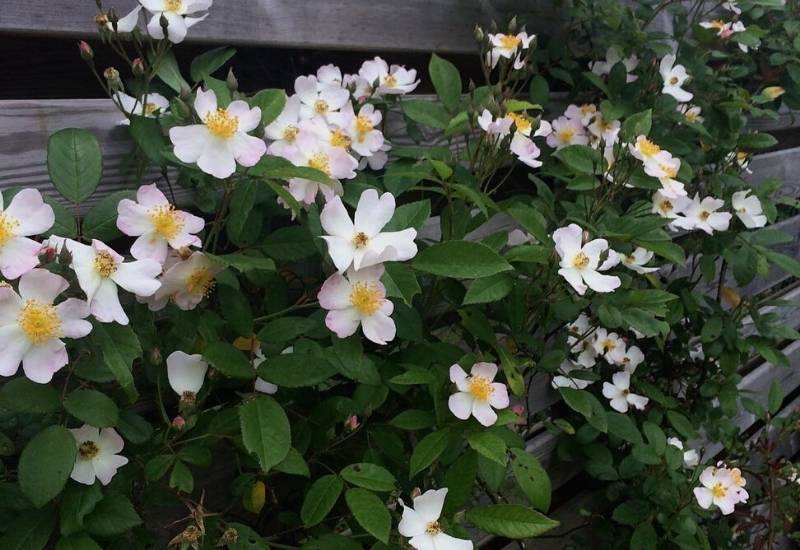
‘Francis E. Leicester’ his a natural looking rambling rose with a strong, musky aroma. It may remind you of a prairie rose, just a bit more “manicured”.
The single flowers are white with lavender pink edges and yellow centers. However, they turn white as they mature.
It’s a large plant you want to fill pergolas or gazebos with amazing fragrance and blooms; alternatively, you can even turn it into a hedge or small tree.
3: Rose ‘Ambridge Rose’ (Rosa ‘Ambridge Rose’)
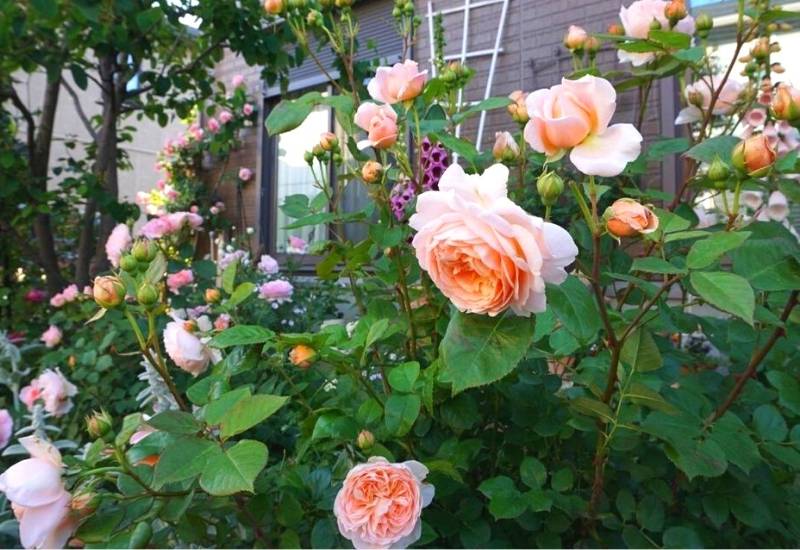
‘Ambridge Rose’ is a small traditional English rose with a strong myrrh scent, so it is very sweet and it has an exotic touch in its fragrance.
The flowers are apricot in color, fully double and very balanced. The petals form a beautiful rosette when they open. It is a marathon bloomer too! It is also a very strong plant, with unusually healthy emerald green foliage.
‘Ambridge Rose’ is perfect for a romantic spot with amazing blossoms and scent from spring to fall! And it’s small enough to fit in a little space.
4: Rose ‘Golden Celebration’ (Rosa ‘Golden Celebration’)
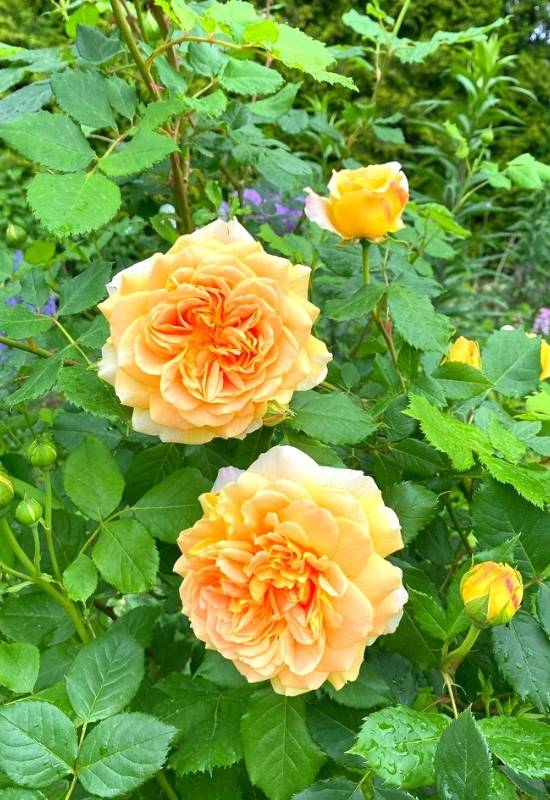
‘Golden Celebration’ is a medium sized English rose with a strong myrrh and fruity aroma combination, fresh and sweet at the same time.
It has an aroma that reminds you of citrus, lychee and strawberry. The fully double cupped flowers are gold yellow and they can have 55 to 75 petals each. You can also train it to be a short climber.
‘Golden Celebration’ is a David Austin rose and winner of the Award of Garden Merit by the Royal Horticultural Society in 2002.
5: Rose ‘Bobbie James’ (Rosa ‘Bobby James’)
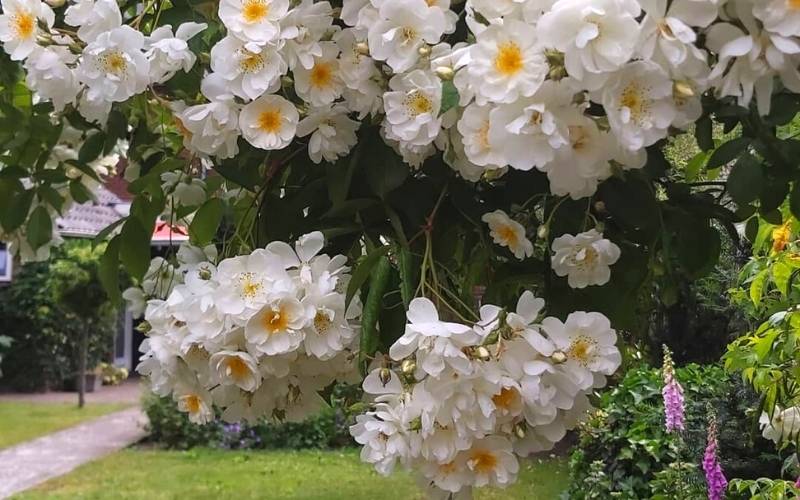
‘Bobby James’ is a candid and natural looking rambling rose with a strong musky fragrance. The small flowers are single and pure white with a bright yellow center.
The leaves are particularly light green in color, and the branches (canes) are purple red! The ensemble is very delicate, light and at the same time traditional looking.
‘Bobby James’ is a large plant that fits a traditional English garden or informal design. It also has a very distinctive look, very “countryside” and bright at the same time.
6: Rose ‘The Poet’s Wife’ (Rosa ‘The Poet’s Wife’)
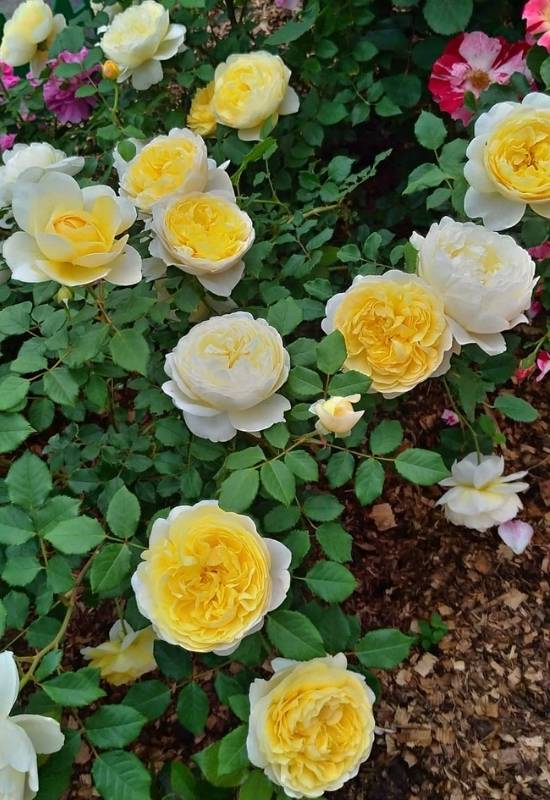
‘The Poet’s Wife’ is a vibrant English shrub rose with a strong fruity smell. It has a hint of lemon in its aroma, which becomes sweeter and stronger as the plant matures!
And it all matches the bright yellow color of the large, fully double flowers, which can reach 5 inches across (12.5 cm). The bushes have a round habit and very shiny foliage.
Grow ‘The Poet’s Wife’ in an informal garden where you want an uplifting and energetic rose to lighten up your days.
7: Rose ‘Kew Rambler’ (Rosa ‘Kew Rambler’)
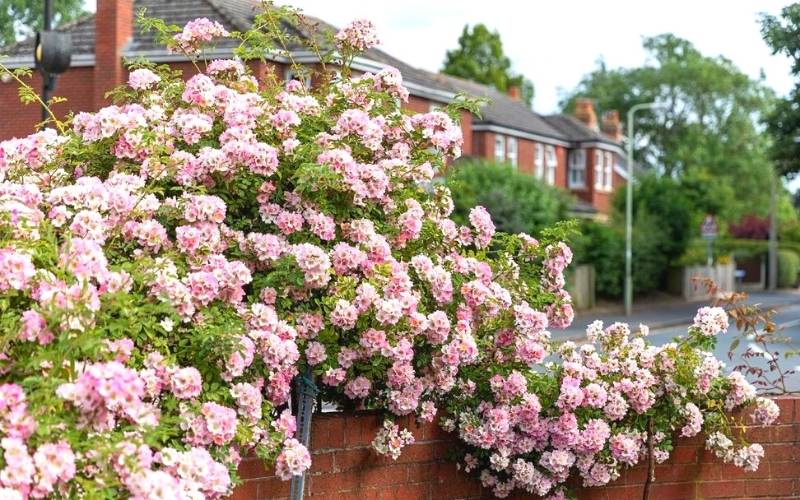
‘Kew Rambler’ is a rambling rose with a traditional look and a strong musky fragrance. The large shrub has small cupped and single flowers with petals that are half white, inside, an half bright pink.
Add the saffron center and the massive blooms and you get the idea.mThe foliage is bright green, which makes the whole plant look light and airy.
‘Kew Rambler’ is ideal for a large and natural looking place, like an English country garden or cottage garden.
8: Rose ‘Lady Emma Hamilton’ (Rosa ‘Lady Emma Hamilton’)
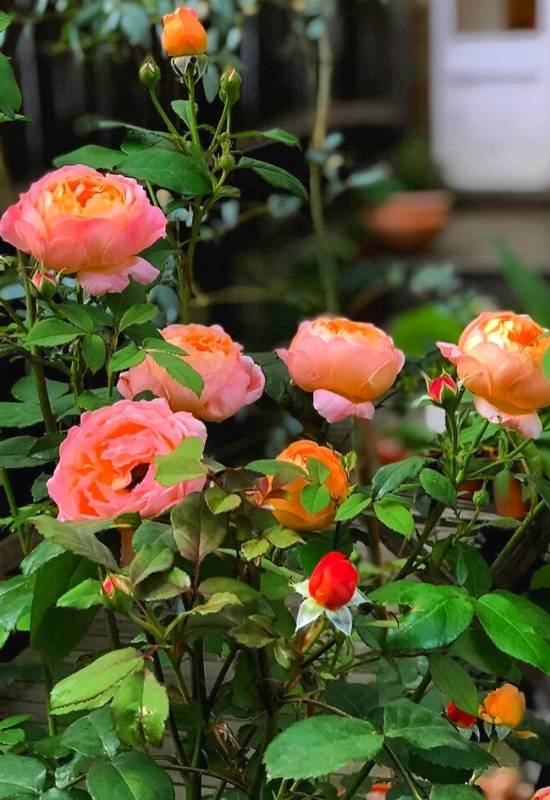
‘Lady Emma Hamilton’ is a spectacular English rose with a fragrance to match its iridescent colors! The aroma is very fruity, a mix of pear, grape and citrus.
The large fully double cupped flowers can have 45 petals and the colors are a mix of shades of pink, tangerine, orange and touches of magenta here and there!
And it blooms for months too… The buds are red, and the leaves are deep emerald in spring, but then they turn purple and finally blue green!
‘Lady Emma Hamilton’ is a star rose, winner of the Award of Garden Merit by the Royal Horticultural Society, and you will want it in a very focal and visible position.
9: Rose ‘Munstead Wood’ (Rosa ‘Munstead Wood’)
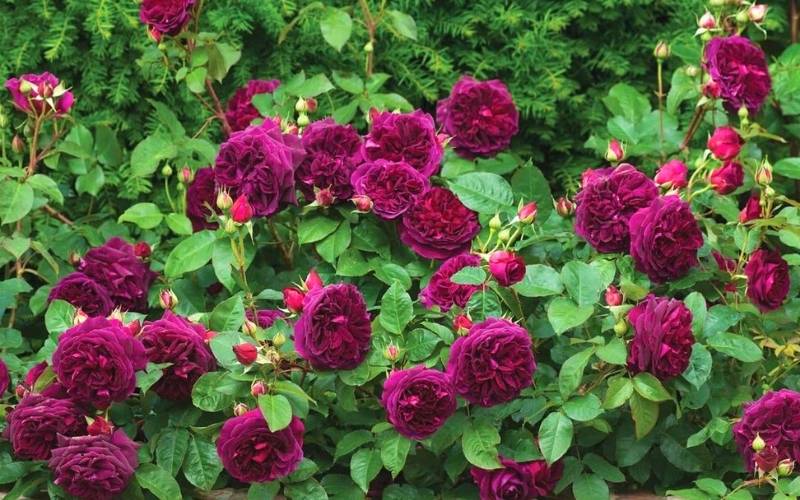
‘Munstead Wood’ is a luxurious looking English rose with a strong and traditional old rose fragrance with fruity notes.
The large and fully double blooms can have 74 petals and they are of a deep velvet crimson color that almost looks purple. The leaves are bronze at first and then they turn mid green.
‘Munstead Wood’ is a small new variety introduced by David Austin in 2007. Ideal for the old rose scent, which is the most iconic rose aroma of all. It also has a very sumptuous appearance and it is small, so suitable for modest places.
10: Rose ‘Paul Noël’ (Rosa ‘Paul Noël’)
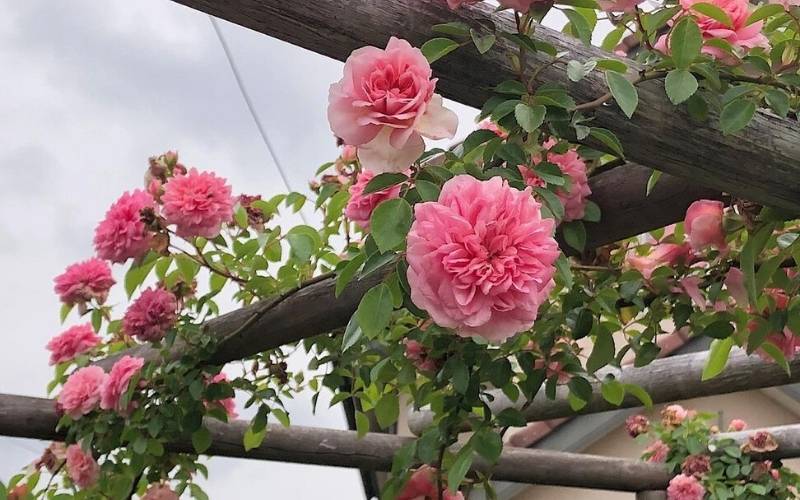
‘Paul Noël’ is a rambling rose with an individual fragrance, which is fruity and apple smelling, with a note of chrysanthemum in it.
The flowers are medium sized, fully double and of a delicate light salmon pink shade. The blooms are massive and repeated and the foliage bright green.
It’s an old and large variety, introduced in 1873 and it is ideal for pergolas, gazebos and gates because it has flexible canes and it is very easy to train. It is also a winner of the Award of Garden Merit by the Royal Horticultural Society.
11: Rose ‘Strawberry Hill’ (Rosa ‘Strawberry Hill’)
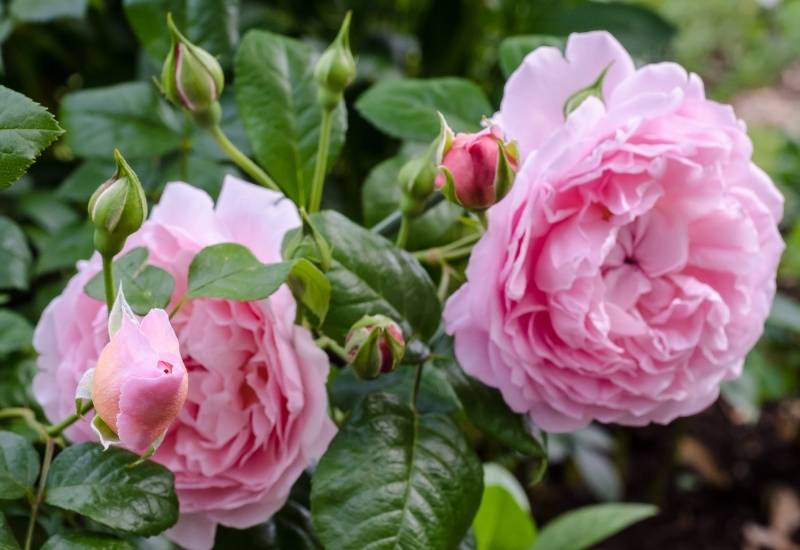
‘Strawberry Hill’ is an English climbing rose bred by David Austin with a strong and sweet myrrh and honey heather fragrance.
The blooms come in clusters of medium, cupped and fully double flowers with pink petals. The leaves are dark green and the branches tend to arch naturally.
‘Strawberry Hill’ is a small to medium size climber, so ideal for suburban front gardens as well as for most informal settings. This fragrant variety too has won the Award of Garden Merit by the Royal Horticultural Society.
12: Rose ‘The Country Parson’ (Rosa ‘The Country Parson’)
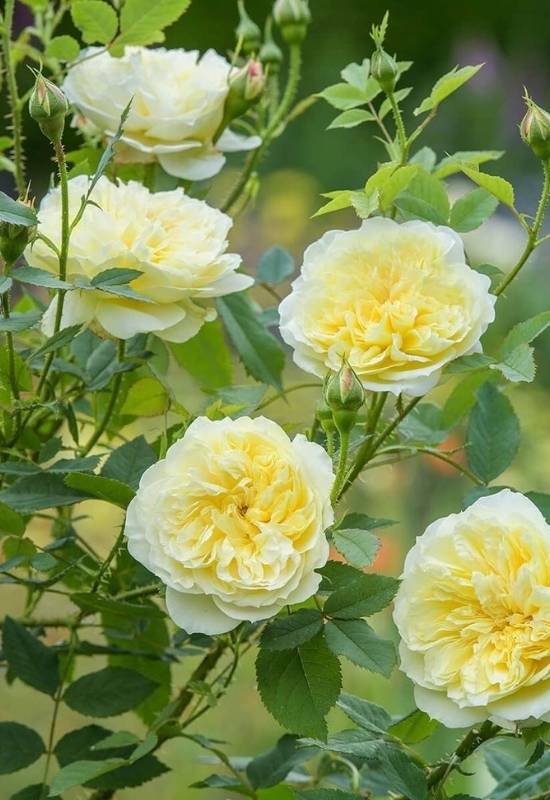
‘The Country Parson’ is an English shrub rose from Scotland with a fruity fragrance that contains notes of sweet apricot, fresh green apple and honey for warmth…
While it is slightly weaker than the other varieties we have seen, it is very original. The blooms are medium sized, fully double and flat, not cupped.
The color is bright, almost lime yellow with lighter and even translucent edges. The emerald leaves frame them perfectly.
‘The Country Parson’ will add an interesting and complex and unusual smell to the brightness of its amazing flowers.
13: Rose ‘Wallerton Old Hall’ (Rosa ‘Wallerton Old Hall’)
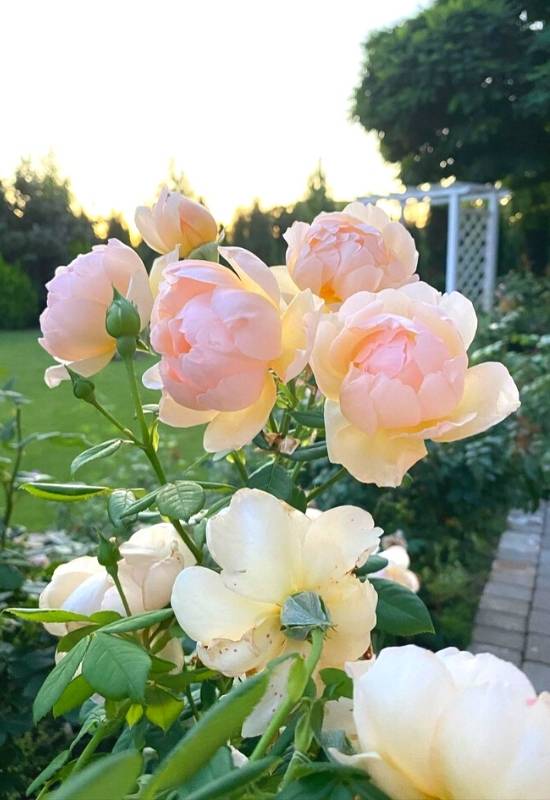
‘Wallerton Old Hall’ is an English climbing rose bred by David Austin with a strong myrrh fragrance complemented by a citrus note.
It has medium sized full double flowers with a very deep cup shape and pale apricot petals. The heads tend to hang on slender stems, like bells. It has bright green foliage.
‘Wallerton Old Hall’ is a rose that looks good in an informal garden where it can bring its light and scent. But note that it is a medium to large climber, so give it plenty of space.
14: Rose ‘Honey Perfume’ (Rosa ‘Honey Perfume’)
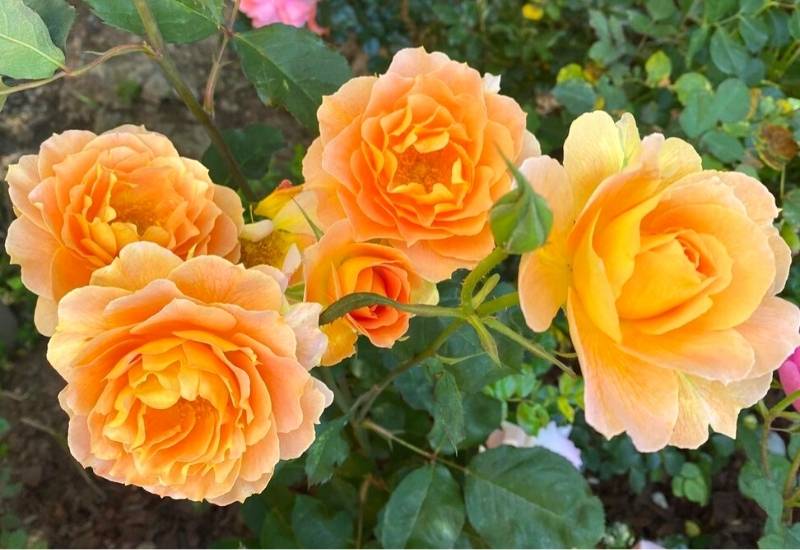
‘Honey Perfume’ is a floribunda rose with a very original fragrance: it has a spicy musky fragrance, which is a mix of nutmeg, cloves, allspice and cinnamon.
The flowers are fully double and large, up to 4 inches across (10 cm) and they open wide to almost flat. The petals are apricot yellow in shade, very rare and beautiful against the deep green foliage.
‘Honey Apricot’ was bred by Dr. Keith Zary in 1993 and it has a special mix of qualities: a very unusual aroma and very refined color.
15: Rose ‘Fragrant Plum’ (Rosa ‘Fragrant Plum’)
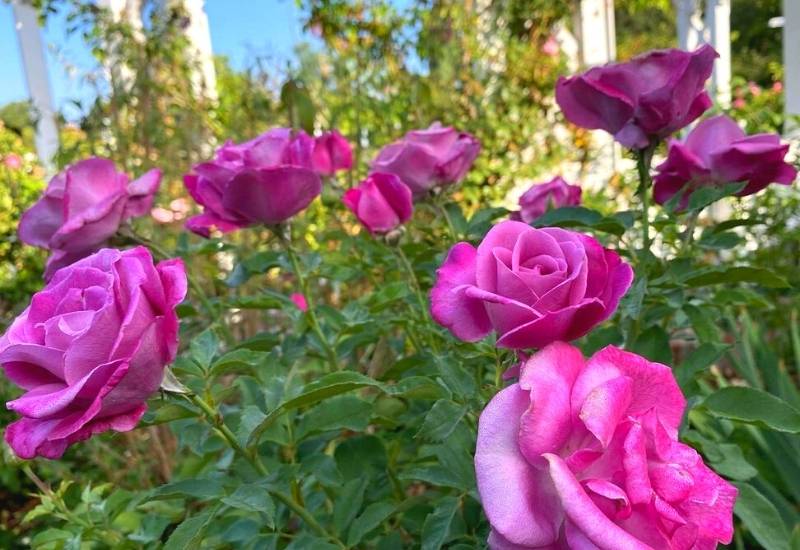
‘Fragrant Plum’ is a grandiflora rose with a fruity fragrance; as the name suggests, it smells like plums. The color of the large,
fully double and elegant roses with wide unfurling petals is light lavender with a darker, magenta shade towards the edges. Purple red stems and dark green foliage completes the picture.
‘Fragrant Plum’ has a welcoming, old world look, very elegant while at the same time original. It is small enough for fairly modest places, but it can also put on a great show in larger settings.
16: Rose ‘Harlow Carr’ (Rosa ‘Harlow Carr’)
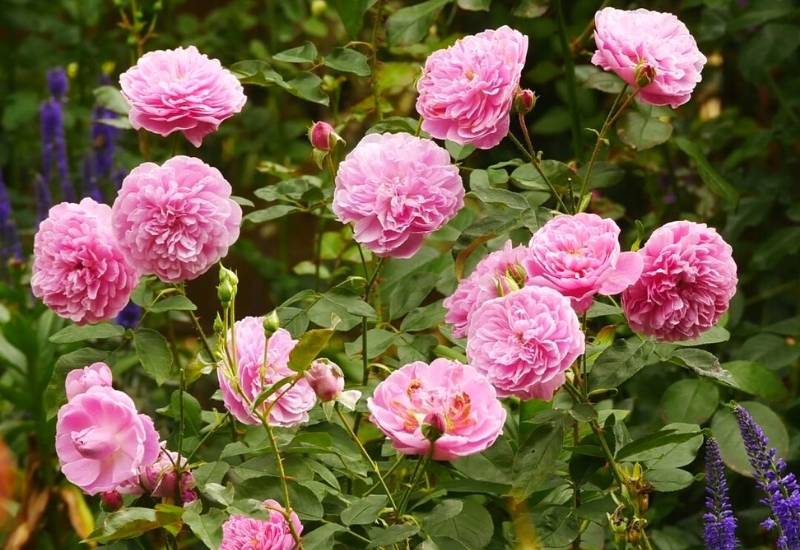
‘Harlow Carr’ is the perfect English shrub rose for a classically looking and traditionally smelling effect. The fragrance is strong and pure old rose in tone. The large, fully double and perfectly cupped blooms are pink with magenta touches in the inside.
This repeat bloomer will have different effects against the foliage, which starts off copper in color in spring and then turns emerald green.
‘Harlow Carr’ has a classical look and smell, and it combines this with a romantic look and color. It is therefore perfect for traditional gardens that want to bring back old times, memories and smells!
17: Rose ‘Gabriel Oak’ (Rosa ‘Gabriel Oak’)
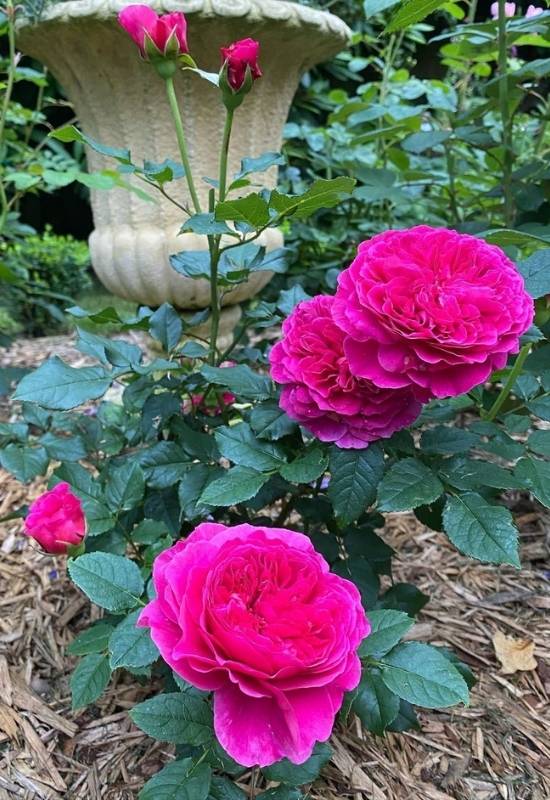
‘Gabriel Oak’ is an English shrub rose with and a strong fruity and soothing fragrance. The large flowers are fully double and they open into flat rosettes.
The petals are of the brightest but deepest carmine pink ever, though they lake slightly over time. The foliage starts off purple and then it turns dark green, so the overall look is very “full” and “intense”.
‘Gabriel Oak’ is an emotionally strong rose; it is medium small but a very strong presence. It’s an ideal variety for a strong effect, in a prominent position.
18: Rose ‘Gertrude Jeckyll’ (Rosa ‘Gertrude Jeckyll’)
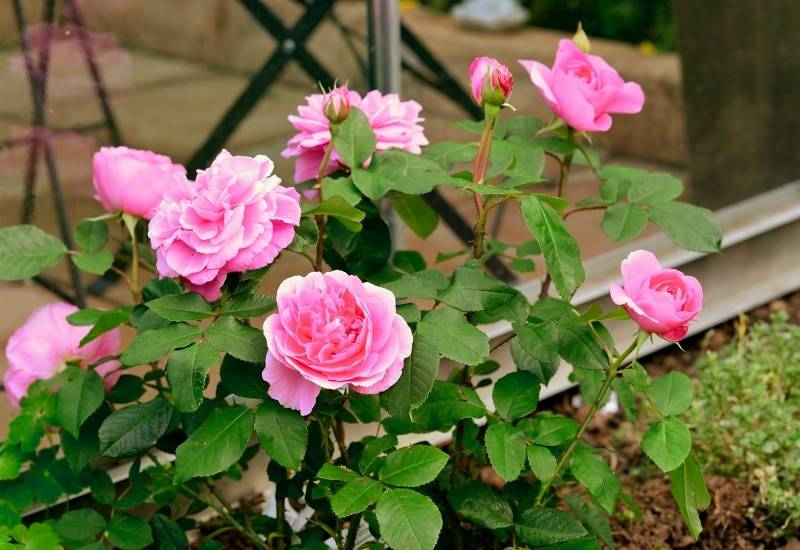
‘Gertrude Jeckyll’ is fragrant rose named after one of history’s most famous gardeners, and one of the first women gardeners, and in fact the “inventor” of the cottage garden!
Fittingly, this variety has a perfect and strong old rose fragrance, and a traditional look. With large, flat and fully double heads with scrolling petals, the bright pink, almost magenta shade just ads the last touch to a rose that says,
“I am the prefect choice for a traditional garden!” This repeat bloomer has light emerald green leaves, and has a balanced shrub shape.
‘Gertrude Jeckyll’ is not just the sweet smelling rose you want for a homage to a gardening icon; it is also the variety you want if believe in her aesthetics: a natural looking, relaxing, gentle garden where plants are the protagonists with their colors and their smells.
Roses for all Types of Noses!
We have gone through a journey of scents and colors that I trust you enjoyed. Note that we started with a famous woman from literature, Desdemona, and ended up with a, actually “the” female pioneer of gardening.
And this ends, on a sweet note, our visit to the world of the most fragrant roses ever…

Written By
Amber Noyes
Amber Noyes was born and raised in a suburban California town, San Mateo. She holds a master’s degree in horticulture from the University of California as well as a BS in Biology from the University of San Francisco. With experience working on an organic farm, water conservation research, farmers’ markets, and plant nursery, she understands what makes plants thrive and how we can better understand the connection between microclimate and plant health. When she’s not on the land, Amber loves informing people of new ideas/things related to gardening, especially organic gardening, houseplants, and growing plants in a small space.

Amber,
Thanks so much for a great, informative, and sweet article!
Out of 18 beautifully smelling roses, I don’t see the one we had in the front yard of our previous residence. Not only did it look gorgeous (just like elegant roses sold at Krogers) but it also had a mesmerizing intense “Old rose” smell. Do you have any guesses for the botanical name of this rose?
Thank you,
Islam
Thank you for your review of this wonderful collection of roses to consider. I have gone with two of them! Still trying to figure out where to place a climber or two. 🙂
Thank You for this inspiration! I am selecting some of these to create a small rose garden in my front yard. I’ve added Scepter ‘d Isle for its sweet pink flowers but mostly for its unique smell of myrr, leather etc. I plan to give the Fragrant maturing flowers to my neighbors who walk by. My garden is organic so they can put them in baths, make rose water sprays for their face or refreshing teas…all different scents and tastes. You said that the aromas are therapeutic and I can thus lift the whole neighborhood up….especially thru are Cold winters! A rose garden is a powerful thing!